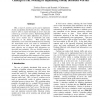Free Online Productivity Tools
i2Speak
i2Symbol
i2OCR
iTex2Img
iWeb2Print
iWeb2Shot
i2Type
iPdf2Split
iPdf2Merge
i2Bopomofo
i2Arabic
i2Style
i2Image
i2PDF
iLatex2Rtf
Sci2ools
ICPPW
2000
IEEE
2000
IEEE
Challenges in URL Switching for Implementing Globally Distributed Web Sites
URL, or layer-5, switches can be used to implement locally and globally distributed web sites. URL switches must be able to exploit knowledge of server load and content (e.g., of reverse caches). Implementing globally distributed web sites offers difficulties not present in local server clusters due to bandwidth and delay constraints in the Internet. With delayed load information, server selection methods based on choosing the least-loaded server will result in oscillations in network and server load. In this paper, methods that make effective use of delayed load information are described and evaluated. The new Pick-KX method is developed and shown to be better than existing methods. Load information is adjusted with probabilistic information using Bloom filter summaries of site content. A combined load and content metric is suggested for use for selecting the best server in a globally distributed site.
Delayed Load Information | Distributed And Parallel Computing | ICPPW 2000 | Server Load | Web Sites |
| Added | 31 Jul 2010 |
| Updated | 31 Jul 2010 |
| Type | Conference |
| Year | 2000 |
| Where | ICPPW |
| Authors | Zornitza Genova, Kenneth J. Christensen |
Comments (0)

